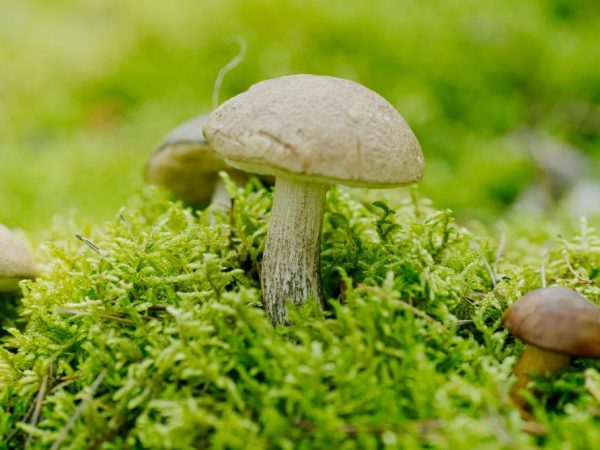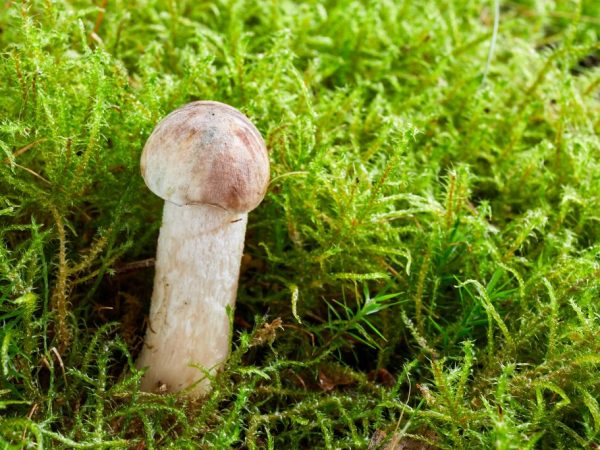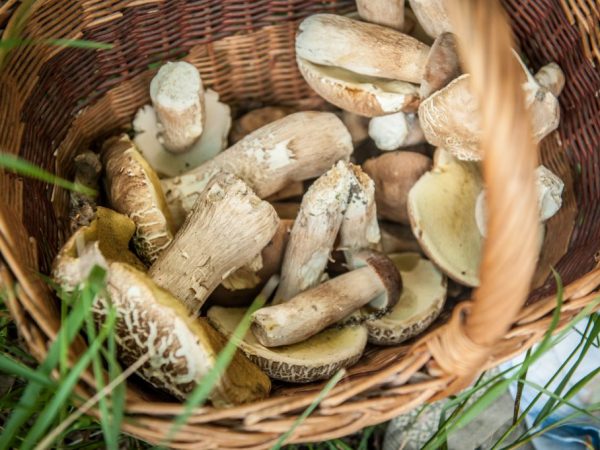Description of the white boletus
White boletus is rare in our area. It has a unique structure and many useful properties. This mushroom is harvested from mid-August to early October inclusive.

Description of the white boletus
Description of appearance
White boletus is of medium size, looks like a boletus. Its cap is white, with a tubular hymenophore and grows to a maximum of 20 cm in diameter, but the minimum can reach only 5 cm. The young mushroom has a hemispherical shape of the cap, which gradually becomes convex, with outstretched sides. The color is white or with a grayish tint. The surface is dry, the structure (to the touch) resembles velvet. Spore-bearing tubules are white with a gray tint; if touched, they will darken. The pores also have a grayish tint.
Irina Selyutina (Biologist):
The color of the white boletus cap resembles the marsh boletus. But there are differences in the internal shape of the cap: in the boletus it is concave, in contrast to the straight or slightly hanging down under the boletus.
Despite all the similarities with the boletus, the boletus has its own differences. Its high leg is up to 4 cm in diameter, thickened at the bottom, has a strong structure, white, has white lagging scales. They darken with age. The pulp at the base has a blue or green tint. The inside is dense, white, when cut, it acquires a lilac-gray hue, over time it turns black from contact with air. The mushroom tastes and smells pleasant, like boletus.
Habitat
According to the ecological characteristics, the fungus is found in the territory of coniferous or mixed forests. Most often it grows near birches, aspens or spruces. In dry weather, these mushrooms can be found in humid, shaded aspen forests. The species is a mycorrhizal forming agent.
Irina Selyutina (Biologist):
White aspen, or white aspen is a rare species. It is found far from all over the territory of Russia, but where it can be found it is included in the regional Red Data Books. At the Russian level, it is also included in the Red Book. In addition to the territory of Russia, this mushroom can also be found in the Baltic States (Estonia, Latvia), Belarus, Western Europe and North America.
White fruiting bodies are found in groups, but they do not grow every year. This is one of the reasons why boletus is considered rare. Deforestation and fires also led to a sharp decrease in the population.
Beneficial features
The advantages of the mushroom:
- able to cleanse the blood;
- is absorbent, therefore it successfully removes harmful substances and heavy metal ions from the body;
- lowers cholesterol;
- restores immunity;
- useful for cancer;
- has a sedative effect;
- restores intestinal microflora;
- regenerates tissue.

Mushroom Has Many Benefits
Contraindications
Mushrooms are edible, but there are several factors to consider when using them for food:
- individual intolerance to the components that make up the fruiting bodies;
- not for children under 7 years old;
- the presence of diseases of the stomach, liver and intestines;
- gout.
If you plan to carry out a course of treatment with this mushroom, you should consult with your doctor in advance.
Application
Boletus is a nutritious product and contains a lot of useful trace elements in the base. Thanks to this, it has become widespread not only in culinary dishes of different nations, but also for medicinal and even cosmetic purposes. Edible mushrooms are great for a variety of dishes.
In cooking
In terms of its nutritional properties and saturation, broth based on these mushrooms is comparable to meat, as well as mushrooms of this type are comparable to meat in nutritional value. They taste tender and pleasant. Any methods of processing them are appropriate: cooking, frying, pickling, salting and drying. In the recipe for red borscht, there is a variant with mushrooms, it goes like a lean one.
The mushroom mostly consists of water, therefore, during the cooking process, its size decreases several times. It is also capable of darkening, but if you marinate it, it will remain the same. To solve the problem with the reduction and darkening of mushrooms, they are soaked for a couple of hours in a solution of citric acid. Advice. The finer the mushrooms are cut for the dish, the better they will be absorbed.

Boletus is nutritious and contains beneficial trace elements in the base
In medicine
White boletus has been widely used as a medical component for the preparation of tinctures. Among the useful medicinal properties of white boletus has the following:
- prevention and treatment of atherosclerosis;
- efficacy in cancer and for their prevention;
- dysbiosis treatment;
- prevention of diseases of the stomach, intestines and liver;
- treatment of nervous disorders, depression;
- strengthening of immunity;
- improvement of complexion, prevention of anemia.
For the preparation of tincture or powder, only caps are used. They take quality vodka or Cahors. Boletus caps are washed, cleaned and cut. After that, they are put into a three-liter jar and poured with vodka or cahors. After the jar is corked and left for 2 weeks in a dark place. Filter and apply 2-4 tbsp. l. in a day. The course of treatment lasts from 1 to 3 months.
Growing methods
White boletus can be grown in any summer cottage. For this, certain methods are used:
- Cultivation by spores: for this, caps of overripe mushrooms are prepared. They are poured with water and infused for a couple of hours. The resulting liquid is poured over the area prepared for planting.
- Planting with crushed parts of fruit bodies: young mushrooms are well crushed and buried in the soil near the trees on the site.
- Using the finished mycelium: it is sold in gardening stores, there are several options. They are planted and looked after according to the instructions attached to the packaged mycelium.
Conclusion
Boletus is a rare mushroom, but it does not lose its popularity. On its basis, delicious dishes are obtained, and its healing properties help with the development of many diseases. If you plant white boletus in your home, you can provide a supply of these beneficial mushrooms for the whole year.



